Charlie Knaggs | |
|---|---|
| Birth name | Charles Peter Huntley Knaggs |
| Allegiance | |
| Service/ | |
| Rank | Colonel |
| Commands | 1st Battalion, Irish Guards |
| Battles/wars | War in Afghanistan |
Charles Peter Huntley Knaggs OBE, [1] is a colonel in the British Army.
Charlie Knaggs | |
|---|---|
| Birth name | Charles Peter Huntley Knaggs |
| Allegiance | |
| Service/ | |
| Rank | Colonel |
| Commands | 1st Battalion, Irish Guards |
| Battles/wars | War in Afghanistan |
Charles Peter Huntley Knaggs OBE, [1] is a colonel in the British Army.
As commander of the First Battalion, Irish Guards, he was Field Officer in Waiting during the Trooping the Colour ceremony in 2005. He was deployed with his battalion to Helmand Province, Afghanistan, shortly thereafter as part of the NATO force providing security.
He was awarded the Order of the British Empire in the 2006 Birthday Honours.
He became the Clerk to the Worshipful Company of Ironmongers in July 2018.

The King's Royal Rifle Corps was an infantry rifle regiment of the British Army that was originally raised in British North America as the Royal American Regiment during the phase of the Seven Years' War in North America known in the United States as 'The French and Indian War.' Subsequently numbered the 60th Regiment of Foot, the regiment served for more than 200 years throughout the British Empire. In 1958, the regiment joined the Oxfordshire and Buckinghamshire Light Infantry and the Rifle Brigade in the Green Jackets Brigade and in 1966 the three regiments were formally amalgamated to become the Royal Green Jackets. The KRRC became the 2nd Battalion, Royal Green Jackets. On the disbandment of the 1st Battalion, Royal Green Jackets in 1992, the RGJ's KRRC battalion was redesignated as the 1st Battalion, Royal Green Jackets, eventually becoming 2nd Battalion, The Rifles in 2007.

A regiment is a military unit. Its role and size varies markedly, depending on the country, service, or specialisation.
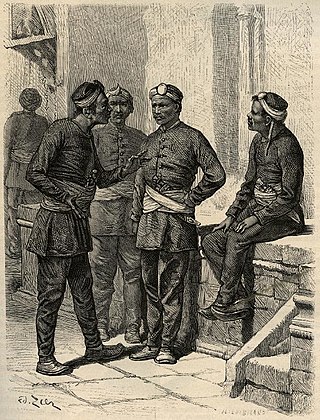
The Gurkhas or Gorkhas, with the endonym Gorkhali, are soldiers native to the Indian subcontinent, chiefly residing within Nepal and some parts of North India.

The Battle of Anzio was a battle of the Italian Campaign of World War II that commenced January 22, 1944. The battle began with the Allied amphibious landing known as Operation Shingle, and ended on June 4, 1944 with the liberation of Rome. The operation was opposed by German and by Italian Repubblica Sociale Italiana (RSI) forces in the area of Anzio and Nettuno.
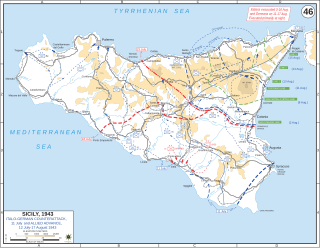
The Allied invasion of Sicily, also known as the Battle of Sicily and Operation Husky, was a major campaign of World War II in which the Allied forces invaded the island of Sicily in July 1943 and took it from the Axis powers. It began with a large amphibious and airborne operation, followed by a six-week land campaign, and initiated the Italian campaign.

British Army of the Rhine (BAOR) was the name given to two British Army formations of the same name. Both were originally occupation forces in Germany, the first after the First World War and the other, active after the Second World War and during the Cold War, eventually becoming part of NATO's contribution to allied forces there. Both formations had areas of responsibility located around the German section of the River Rhine.
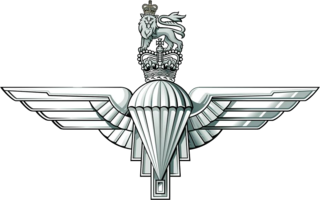
The Parachute Regiment, colloquially known as the Paras, is the airborne and elite infantry regiment of the British Army. The first battalion is part of the Special Forces Support Group under the operational command of the Director Special Forces. The other battalions are the parachute infantry component of the British Army's rapid response formation, 16 Air Assault Brigade. The Paras, along with the Guards, are the only line infantry regiment of the British Army that has not been amalgamated with another unit since the end of the Second World War.

The New Army, often referred to as Kitchener's Army or, disparagingly, as Kitchener's Mob, was an (initially) all-volunteer portion of the British Army formed in the United Kingdom from 1914 onwards following the outbreak of hostilities in the First World War in late July 1914. It originated on the recommendation of Herbert Kitchener, then the Secretary of State for War to obtain 500,000 volunteers for the Army. Kitchener's original intention was that these men would be formed into units that would be ready to be put into action in mid-1916, but circumstances dictated the use of these troops before then. The first use in a major action of Kitchener's Army units came at the Battle of Loos.

The South Staffordshire Regiment was a line infantry regiment of the British Army in existence for only 68 years. The regiment was created in 1881 under the Childers Reforms by the amalgamation of the 38th Regiment of Foot and the 80th Regiment of Foot. The regiment saw service in the Second Boer War, World War I and World War II.

The Manchester Regiment was a line infantry regiment of the British Army in existence from 1881 until 1958. The regiment was created during the 1881 Childers Reforms by the amalgamation of the 63rd Regiment of Foot and the 96th Regiment of Foot as the 1st and 2nd battalions; the 6th Royal Lancashire Militia became the 3rd (Reserve) and 4th battalions and the Volunteer battalions became the 5th, 6th, 7th, 8th, 9th and 10th battalions.
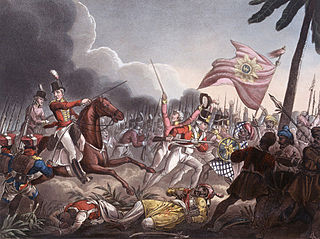
The Battle of Assaye was a major battle of the Second Anglo-Maratha War fought between the Maratha Confederacy and the British East India Company. It occurred on 23 September 1803 near Assaye in western India. An outnumbered Indian and British force, under the command of Major General Arthur Wellesley, defeated the combined Maratha army of Daulatrao Scindia and the Bhonsle Raja of Berar. The battle was Wellesley's first major victory and the one he later described as his finest accomplishment on the battlefield, even more so than his more famous victories in the Peninsular War, and his defeat of Napoleon Bonaparte at the Battle of Waterloo.
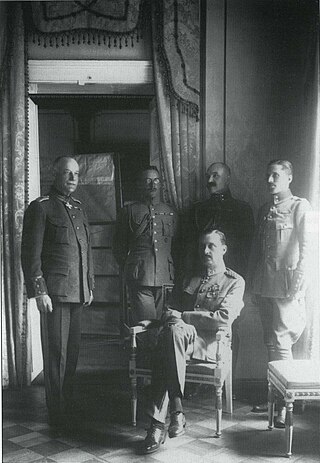
Adjutant is a military appointment given to an officer who assists the commanding officer with unit administration, mostly the management of human resources in an army unit. The term adjudant is used in French-speaking armed forces as a non-commissioned officer rank similar to a staff sergeant or warrant officer but is not equivalent to the role or appointment of an adjutant.

The Third Anglo-Afghan War began on 3 May 1919 when the Emirate of Afghanistan invaded British India and ended with an armistice on 8 August 1919. The Anglo-Afghan Treaty of 1919 resulted in the Afghans re-gaining dejure control of foreign affairs from Britain, and the recognition of the Durand Line as the border between Afghanistan and British India.

The Royal Gurkha Rifles (RGR) is a rifle regiment of the British Army, forming part of the Brigade of Gurkhas. Unlike other regiments in the British Army, RGR soldiers are recruited from Nepal, which is neither a dependent territory of the United Kingdom nor a member of the Commonwealth.

The Essex Regiment was a line infantry regiment of the British Army in existence from 1881 to 1958. The regiment served in many conflicts such as the Second Boer War and both World War I and World War II, serving with distinction in all three. It was formed in 1881 under the Childers Reforms by the amalgamation of the 44th Regiment of Foot and the 56th Regiment of Foot.

The Buffs (Royal East Kent Regiment), formerly the 3rd Regiment of Foot, was a line infantry regiment of the British Army traditionally raised in the English county of Kent and garrisoned at Canterbury. It had a history dating back to 1572 and was one of the oldest regiments in the British Army, being third in order of precedence (ranked as the 3rd Regiment of the line). The regiment provided distinguished service over a period of almost four hundred years accumulating one hundred and sixteen battle honours. In 1881, under the Childers Reforms, it was known as the Buffs (East Kent Regiment) and later, on 3 June 1935, was renamed the Buffs (Royal East Kent Regiment).

The Royal Scots Fusiliers was a line infantry regiment of the British Army that existed from 1678 until 1959 when it was amalgamated with the Highland Light Infantry to form the Royal Highland Fusiliers which was later itself merged with the Royal Scots, King's Own Scottish Borderers, the Black Watch, the Argyll and Sutherland Highlanders and the Highlanders to form a new large regiment, the Royal Regiment of Scotland.

The Mahar Regiment is an infantry regiment of the Indian Army. Although it was originally intended to be a regiment consisting of troops from the Mahar community of Maharashtra, today the Mahar Regiment is composed of different communities from mainly states like Maharashtra, Gujarat, Madhya Pradesh, Uttar Pradesh, and Bihar.

The King's Shropshire Light Infantry (KSLI) was a light infantry regiment of the British Army, formed in the Childers Reforms of 1881, but with antecedents dating back to 1755. It served in the Second Boer War, World War I, World War II and Korean War. In 1968, the four regiments of the Light Infantry Brigade amalgamated to form The Light Infantry, with the 1st KSLI being redesignated as the 3rd Battalion of the new regiment.

The Special Reserve was established on 1 April 1908 with the function of maintaining a reservoir of manpower for the British Army and training replacement drafts in times of war. Its formation was part of the military reforms implemented by Richard Haldane, the Secretary of State for War, which also created the Territorial Force. Haldane originally intended that the Militia would provide the reserve, but opposition from its representatives forced him to abolish it and create the Special Reserve instead. Only 60 per cent of the Militia transferred into the new reserve, and it was consistently under strength, particularly in officers. Reservists enlisted for a six-year term of service, and had to undergo six months of basic training on recruitment and three to four weeks training annually.